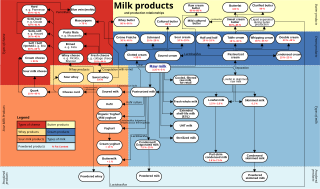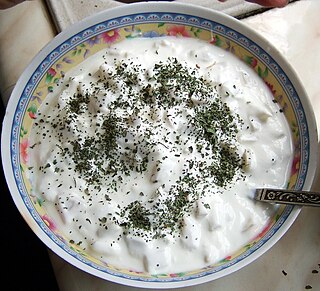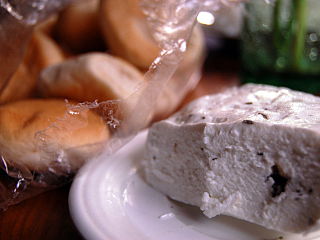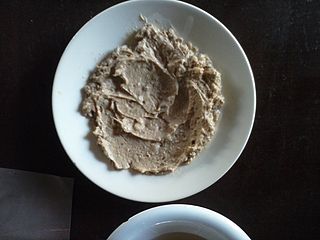
Dairy products or milk products, also known as lacticinia, are food products made from milk. The most common dairy animals are cow, water buffalo, nanny goat, and ewe. Dairy products include common grocery store food items in the Western world such as yogurt, cheese, milk and butter. A facility that produces dairy products is known as a dairy. Dairy products are consumed worldwide to varying degrees. Some people avoid some or all dairy products either because of lactose intolerance, veganism, or other health reasons or beliefs.

Cottage cheese, also known as curds and whey, is a curdled milk product with a mild flavor and a creamy, heterogenous, soupy texture. It is made from skimmed milk by draining curds but retaining some of the whey and keeping the curds loose. An essential step in the manufacturing process distinguishing cottage cheese from other fresh cheeses is the addition of a "dressing" to the curd grains, usually cream, which is mainly responsible for the taste of the product. Cottage cheese is not aged.

Curd is obtained by coagulating milk in a sequential process called curdling. It can be a final dairy product or the first stage in cheesemaking. The coagulation can be caused by adding rennet, a culture, or any edible acidic substance such as lemon juice or vinegar, and then allowing it to coagulate. The increased acidity causes the milk proteins (casein) to tangle into solid masses, or curds. Milk that has been left to sour will also naturally produce curds, and sour milk cheeses are produced this way.

Buttermilk is a fermented dairy drink. Traditionally, it was the liquid left behind after churning butter out of cultured cream. As most modern butter in western countries is not made with cultured cream but uncultured sweet cream, most modern buttermilk in western countries is cultured separately. It is common in warm climates where unrefrigerated milk sours quickly.

Paneer, also known as ponir, is a fresh acid-set cheese common in cuisine of the Indian subcontinent made from full-fat buffalo milk or cow milk. It is a non-aged, non-melting soft cheese made by curdling milk with a fruit- or vegetable-derived acid, such as lemon juice.
Žinčica, Žinčice, Żętyca, Жентиця, or Zyntyca is a drink made of sheep milk whey similar to kefir consumed mostly in Slovakia and Poland. It is a by-product in the process of making bryndza cheese.

Kashk, qurut, chortan, or aaruul and khuruud is a range of dairy products popular in Middle Eastern cuisine, Caucasian cuisine, and Central Asian cuisine. Kashk is made from strained yogurt, drained buttermilk or drained sour milk by shaping it and letting it dry. It can be made in a variety of forms, like rolled into balls, sliced into strips, and formed into chunks.
Mithai (sweets) are the confectionery and desserts of the Indian subcontinent. Thousands of dedicated shops in India, Bangladesh, Nepal, Pakistan and Sri Lanka sell nothing but sweets.

Clabber is a type of soured milk. It is produced by allowing unpasteurized milk to turn sour (ferment) at a specific humidity and temperature. Over time, the milk thickens or curdles into a yogurt-like consistency with a strong, sour flavor. In Joy of Cooking, "Clabber... is milk that has soured to the stage of a firm curd but not to a separation of the whey."

Matzoon or matsoni is a fermented milk product of Armenian origin, distributed in Armenia and Georgia. The so-called Caspian Sea yogurt circulated and commercialized in Japan is sometimes said to be the same type of yogurt as matzoon, but a comparison of microbiota and viscosity found that the two are entirely different.

Strained yogurt, Greek yogurt, yogurt cheese, sack yogurt, kerned yogurt, or Turkish yogurt is yogurt that has been strained to remove most of its whey, resulting in a thicker consistency than normal unstrained yogurt, while still preserving the distinctive sour taste of yogurt. Like many types, strained yogurt is often made from milk enriched by boiling off some water content, or by adding extra butterfat and powdered milk. In Europe and North America, it is often made from low-fat or fat-free cow's milk. In Iceland, a similar product named skyr is made.

Kesong puti is a Filipino soft, unaged, white cheese made from unskimmed carabao milk and salt curdled with vinegar, citrus juices, or sometimes rennet. It can also be made with goat or cow milk. It has a mild salty and tart flavor. When an acidifying agent is used, it resembles queso blanco or paneer. When rennet is used, it resembles buffalo mozzarella. Moisture content can also vary, ranging from almost gelatinous to pressed and firm. It can be eaten as is, paired with bread, or used in various dishes in Filipino cuisine. It is usually sold wrapped in banana leaves.

Egyptian cheese has a long history, and continues to be an important part of the Egyptian diet. There is evidence of cheese-making over 5,000 years ago in the time of the First Dynasty of Egypt. In the Middle Ages the city of Damietta was famous for its soft, white cheese. Cheese was also imported, and the common hard yellow cheese, rumi, takes its name from the Arabic word for "Roman". Although many rural people still make their own cheese, notably the fermented mish, mass-produced cheeses are becoming more common. Cheese is often served with breakfast, and is included in several traditional dishes, and even in some desserts.

Mish is a traditional Egyptian cheese that is made by fermenting salty cheese for several months or years.

Jocoque or jocoqui is a Mexican dairy product based on fermented milk, from uncertain origins, influenced by Lebanese cuisine.

Curd, also mosaru or dahi or Thayir or Perugu, is a traditional yogurt or fermented milk product, originating from and popular throughout the Indian subcontinent, usually prepared from cow's milk, and sometimes buffalo milk, or goat milk. The word curd is used in Indian English to refer to homemade yogurt, while the term yogurt refers to the pasteurized commercial variety known as heat treated fermented milk.

Yemeni cheese also known as Taiz cheese and known in Yemen as "local cheese", is a type of Yemeni cheese that is produced in rural areas of Yemen most famously in Taiz Governorate which is why it is known as Taizz cheese although other local names are given based on the region or the village the cheese was produced. Visitors to Taiz city usually buy the Taiz cheese in al-Bab al-Kabeer and Bab Musa markets as gifts for their families. The production of the Taiz cheese has not been affected by the production of processed cheese because most Yemenis still prefer the local cheese.

Yayık ayranı, also known as Turkish buttermilk, is a traditional Turkish drink produced from fermented buttermaking by-products, water and salt. It has been traditionally prepared in barrel churns or skin bags. Despite the similar name, it is distinct from ayran. Goat, sheep, or cow's milk can be used for Turkish buttermilk production. Certain acid curd cheeses such as çökelek could also be obtained from yayık ayranı when heated.
















